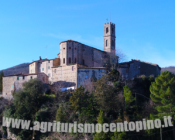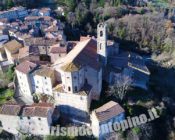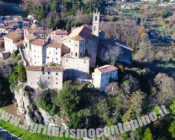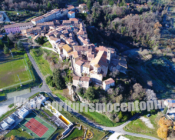The village of Sasso Pisano in Tuscany
What to visit
Restaurants
Where to stay
Shops
truscan thermal complex of Sasso Pisano: The archaeological site is being restored and is closed to visitors, so it is possible to visit it only from the outside, it is Etruscan baths of the late Hellenistic period. Also you can access the pools of sulphurous water that flows naturally from the ground at a temperature above 45 ° C, access is free. A place of maximum calm, relaxing and surrounded by nature.
Historical details: the complex called “Il Bagnone” was built to take advantage of the nearby hot springs with which baths were used for bathing, in the Hellenic era the complex was exploited by the local population, the sulphurous water also fed a large fountain open on one side of the porch. The water of this important spa complex called “Aquae Volaterrae” is represented in the Tabula Peutingeriana, a medieval copy of a military road map of the Roman Imperial age. The most important findings that have been found can be found at the Antiquarium “Il Canapaio” in Sasso Pisano.
The Biolago di Sasso Pisano: a recently opened caldarium with 36-degree water and whirlpool, equipped with a tepidarium and a phyto-clear pond at room temperature. The small pools are located at the foot of the rock spur on which the village of Sasso Pisano was built. The waters come partly from the sources of the surrounding areas and partly heated by the geothermal steam in the area, therefore with zero emissions. Admission costs a few euros.
The fumaroles and putizzas of Sasso Pisano: downstream of this small town you can visit the “Parco delle Fumarole” in the locality of the Lagone del Sasso. You will be able to see small geysers emerging from the ground. The whole is based on a very banal principle, this area possesses pockets of water and very hot rocks in the first substrates of the soil, the heat transforms the water into steam that escapes from the earth in a natural way. This characteristic of the Larderello area is unique throughout the world. A suggestive route between fumaroles and pits that connects Sasso Pisano with Monterotondo Marittimo. Do not forget to visit the heart of Geothermal in Larderello.
You will find details and information in the tourist office of Sasso Pisano located inside the Antiquarium “Il Canapaio”, in Via dei Lagoni in Sasso Pisano.
Brewery craft “Vapori di Birra” to accompany the beer tasting you can find cheeses, meats, honey, oil and wine provided by local producers.
Restaurant – “Il Tinaio”
Our Villas are located about 30 minutes from Sasso Pisano. You can book or ask more information by clicking on Booking.
inimarket “La Bottega SMA” to buy groceries.
obacco shop “Minerva” by Ciampini Luigi.
harmacy by Martino Gennaro (via Cavour 18) for the purchase of medicines and products for the body.
History of Sasso Pisano
The morphology of Sasso Pisano
History of Sasso Pisano
Sports and entertainment in Sasso Pisano
The post-war in Sasso Pisano
Enel arrives, the boraciferous village is born
1960-1961 years of iron and steel
The Etruscan Thermal of Sasso Pisano
Buca di San Rocco Pellegrino di Monpelier
efore reaching the current name, the village of Sasso Pisano was called, initially saxo, then Castello di Saxo and later saxo di Maremma.The etymon “Sasso” is of morphological origin and refers to the rocky spur of calcareous origin on which the castle of Sasso Pisano was built. The country is not large, all grouped around the church and the barracks of the royal carabinieri. Nineteen earth around the houses locked to each other, in solidarity, as was the people who lived there, all linked by common poverty. The first settlement in Sasso Pisano in the VII century was of Lombard origin. The geographic arrangement and the height of the Sasso made it easily defensible allowing an excellent view from the top. The surrounding area offered wood rich in timber to be exploited as heat for the processing of metals. The area in the surrounding plains was full of boiling water that escaped from the subsoil. This great resource of the subsoil was exploited by the Etruscans and today the Etruscan baths have acquired great value as they are the only example of baths that have come down to us from the late Hellenistic period.
n 1826 the inhabitants of Sasso Pisano (called Sasserini), there were 1089 units, the economy was mainly agricultural but also the craftsmen were numerous: at least 4 blacksmiths, 4 carpenters and 1 mechanic and a tailor who met the needs of the inhabitants of Sasso Pisano.The Families were numerous: even 9 or 10 children, 4 children were in the norm. This is because in a predominantly agricultural country the arms were important.
he sport practiced in the past by the boys was the ball: the ball was nothing but a handful of rags held together by a wire. In 1838 the bold Sasso was born, which still today engages in matches with teams from surrounding countries. Another game played in the past in Sasso Pisano was that of the tumbles: a circle of iron driven by a rod with a bow called Mandino at the bottom, the best were already able to make wooden carts with wooden wheels. Often between the band of the squires and the band of the landers (the two main bands of Sasso Pisano) clashed with fists or stones, fortunately the wounded were not the order of the day. Instead, the adults went out in the afternoon and in the evening to play cards and drink alcohol in the tavern. The peasants, on the other hand, spent their evenings “waking up”, that is, they spent their time telling each other stories by candlelight or by doing accordion-like dance parties.
t the end of the Second World War the arrival of the Americans had brought to Sasso Pisano new products such as: candy with the hole, the cocacola, new dances not to mention motorcycles and radios. Sunday was considered a very important day so the best dress was worn, the newest. The group of boys and the group of girls, both well dressed, took the occasion of Sunday mass to look at each other and exchange a smile or a wink.
great positive change in the life of the population came with the election in 1954 of President Fascetti della Larderello (ie the current Enel). In the three years of his presidency he built an entire village for the factory workers: “The boraciferous village”. The village consisted of many terraced houses with gardens and trees, an asylum, a chapel, the church of the lagoni (designed by michelucci who was the best architect of the time). A leisure club, a bowling alley, an indoor cinema were built and all these facilities were heated free of geothermal steam. Of equal importance were the many assumptions made by Larderello at that time.
he Italsider of piombino in recent years expanded its facilities and a large part of the population, not assumed by Larderello, then remained peasant emigrated to Piombino and Venturina in search of a well-paid job, vacation and pension guaranteed: all that not he would arrive while remaining a peasant. The Italsider workers created a new life and their children never returned to Sasso Pisano.
f great artistic and structural importance the thermal plant, in Sasso Pisano there was in fact a spa built by the Etruscans. The Etruscan thermal baths of Sasso are the only surviving Etruscan thermal baths in good condition up to the present day. Today this discovery has been included in a project for the creation of an archaeological park open to visitors that thanks to geothermal energy, ie the presence of hot rocks at low depths containing large pockets of steam and sulphurous water, promotes cultural tourism. This surreal environment, where the steam escapes from the ground at a high temperature has given rise to various legends including that of Monpelier.
ere the legend goes back to the 1300s after having healed the sick of the plague, with the simple sign of the cross. San Rocco Pellegrino of Monpelier contracted the disease in Piacenza while he was returning to France, not wanting to die without the blessing of the Holy Father, if he was on his way to Rome, but exhausted stopped in a wild area covered with forests and pregnant with nauseating vapors. He found this cave overlooking the warm lake, rich in sulfur and borates. After wetting and having breathed, the sour smell healed. The fact was known in the territory and some travelers erected a small church under the castle. Even today the floor in front of the cave is called Troscia dal Longobardo “pozzanghera“.











